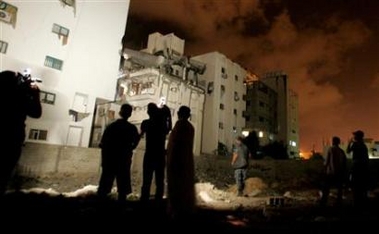Israeli missiles tore through the Palestinian Interior Ministry in Gaza on
Wednesday, causing extensive damage, as Israel kept up nightly air attacks to
pressure militants to release an abducted soldier.

People look at the
damaged building of the Palestinian Interior Ministry, following an air
strike in Gaza City, early July 5,
2006.[Reuters] |
The air strike, which wounded at least 3 people, was launched hours after
militants from the governing Hamas movement fired a rocket into a main Israeli
city for the first time, an attack that deepened a 10-day-old crisis.
Israeli Prime Minister Ehud Olmert planned to consult with his security
cabinet later in the day on stronger military action following the attack on
coastal city of Ashkelon, government officials said.
Gaza residents were shaken from their beds by the now-familiar sound of a
massive explosion as shrapnel and rubble flew from the five-story Interior
Ministry building. The air raid damaged upper floor and adjacent apartments,
where medics rushed children suffering from shock to hospital.
Another Israeli air strike targeted an empty school in northern Gaza which a
military spokeswoman said was used by Hamas activists at night. There were no
reports of injuries.
In the southern Gaza Strip, Israeli aircraft attacked a training camp used by
Hamas militants. Palestinians said the facility had been abandoned before the
strike.
Israeli aircraft struck the same Interior Ministry complex on June 30, five
days after gunmen from Hamas's armed wing and two other factions snatched
Corporal Gilad Shalit in a cross-border raid into Israel from Gaza.
The army said an upgraded Qassam rocket, powered by two engines instead of
the usual single motor, and flying 12 km (7 miles), slammed into a school yard
in the center of Ashkelon, a city of about 115,000 and the site of a main power
plant.
No one was hurt, but Olmert made clear militants had crossed a red line in
their deepest rocket attack yet into Israel.
"This is an escalation without precedent in the terrorist war waged by the
Hamas movement that now controls the Palestinian Authority," Olmert said in a
speech at a U.S. Independence Day celebration at the American ambassador's
house.
"This (rocket) attack ... will have unprecedented, far-reaching consequences.
The Hamas organization will be the first to feel them," he said, after its Izz
el-Deen al-Qassam Brigades claimed responsibility for the strike.
Hamas said in a statement it was not frightened by what it termed Zionist
threats. Israel has hinted it could assassinate leaders of Hamas, whose
government is under an international aid embargo, if Shalit is not freed.
"If blood is shed in Gaza, the streets and communities of the Zionist entity
will not be spared," Hamas said.
On Tuesday, Israel ignored an ultimatum by the groups that abducted Shalit to
begin freeing 1,000 Palestinian prisoners, as well as jailed women and youths.
Olmert termed the demand extortion. The factions vowed not to release any
information about the 19-year-old tank gunner and pulled out of negotiations
with Egyptian mediators trying to end the standoff, a Hamas political leader
said.
Israeli armor moved into the southern Gaza Strip a week ago, taking up
largely static positions at a disused airport.
Israel has also sent tanks into the northern Gaza Strip, the main launching
area for Qassam rockets. But it has stopped short of a push into Gaza towns,
where fighting with militants would likely be intense.
After the Ashkelon attack, an Israeli Web site, Arutz 7, quoted Defense
Minister Amir Peretz as saying in an interview he had ordered the army to step
up Gaza operations to bring Shalit home and halt Qassam attacks.
Militants in Gaza, territory Israel quit last year after 38 years of
occupation, have been firing rockets daily into southern Israel, causing few
casualties.
Many have hit Sderot, a backwater town, making less of a political impact in
Israel than the attack on Ashkelon -- a city that right-wing opponents of the
Gaza pullout, which Olmert backed, had predicted would eventually be
hit.